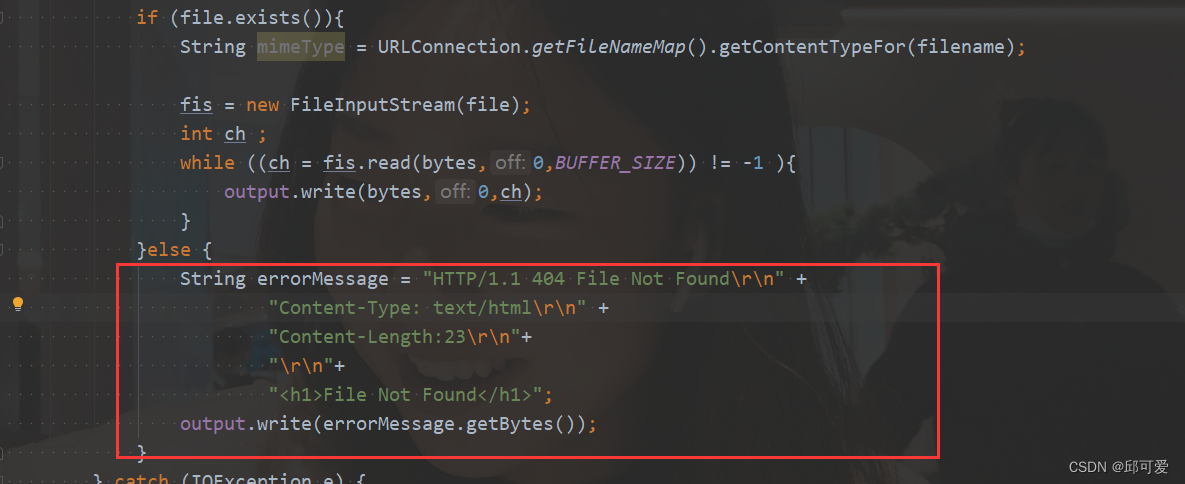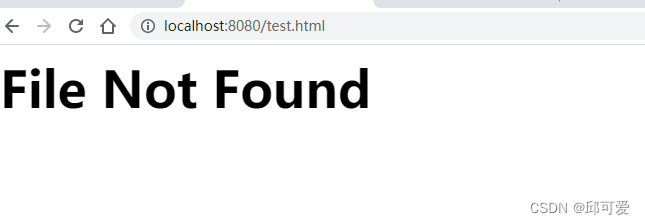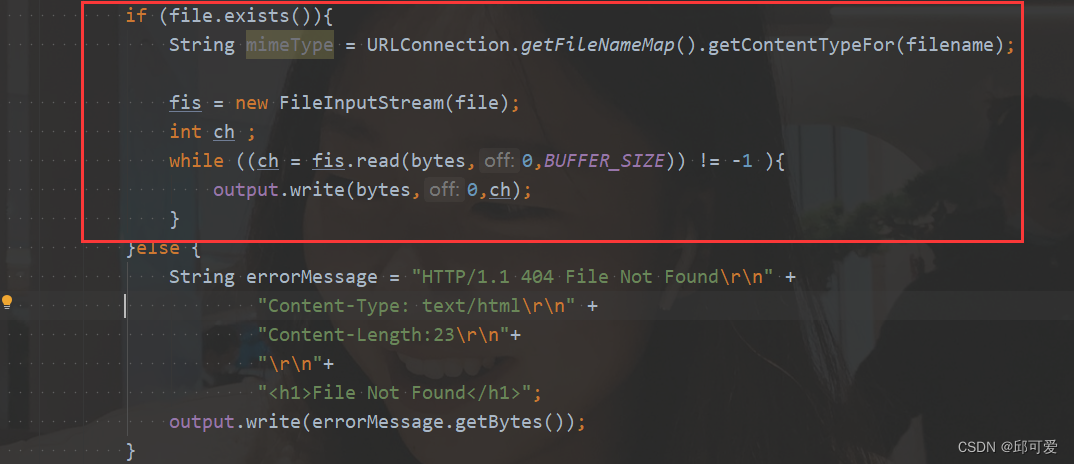前言
前段时间刚学完《Java网络编程》,最近着手学习《深入剖析Tomcat》,但是这里第一个案例就出现了问题。建议稍微有点网络基础的同学看。
书上源码多自己思考,根据已有知识排错。
前置知识
HTTP
- 基于可靠TCP建立连接。
- 发送请求、响应请求
- 断开连接
HTTP请求
请求:
- 请求方法、URI、协议版本
- 请求头
- 实体
请求头和请求体之间有一个空行。
响应:
- 协议、状态码、描述
- 响应头
- 响应实体
响应头和响应体之火箭有一个空行
Socket类
不细说了,参见net模块的笔记。
问题简述
问题代码
package chapter01.demo01;
import java.io.IOException;
import java.io.InputStream;
import java.io.OutputStream;
import java.net.*;
import java.util.Objects;
/**
* @description HTTP服务器
* 阻塞的监听指定的应用程序,如果发现接收到请求就解析成Request
* 如果uri是关闭,就不再循环;否则将对应的uri资源封装成response返回
*
* @date:2022/11/3 15:52
* @author: qyl
*/
public class HttpServer {
// 指定资源路径
public static final String WEB_ROOT = Objects.requireNonNull(HttpServer.class.getClassLoader().getResource("webroot")).getPath();
private static final String SHUTDOWN_COMMAND = "/SHUTDOWN";
private boolean shutdown = false;
public static void main(String[] args) {
HttpServer server = new HttpServer();
server.await();
}
private void await() {
int port = 8080;
try (ServerSocket serverSocket = new ServerSocket(port, 1, InetAddress.getByName("127.0.0.1"))){
while (!shutdown) {
try (Socket socket = serverSocket.accept()) {
// 解析请求
InputStream input = socket.getInputStream();
Request request = new Request(input);
request.parse();
// 封装响应
OutputStream output = socket.getOutputStream();
Response response = new Response(output);
response.setRequest(request);
// 发送响应
response.sendStaticResource();
shutdown = request.getUri().endsWith(SHUTDOWN_COMMAND);
} catch (IOException e) {
e.printStackTrace();
}
}
} catch (IOException e) {
e.printStackTrace();
System.exit(1);
}
}
}
```java
package chapter01.demo01;
import java.io.*;
import java.net.URLConnection;
/**
* @description
* @date:2022/11/3 16:10
* @author: qyl
*/
public class Response {
private static final int BUFFER_SIZE = 1024;
Request request;
OutputStream output;
public Response(OutputStream output){
this.output = output;
}
public void setRequest(Request request){
this.request = request;
}
public void sendStaticResource() throws IOException {
byte[] bytes = new byte[BUFFER_SIZE];
FileInputStream fis = null;
try{
String filename = request.getUri();
File file = new File(HttpServer.WEB_ROOT,filename);
if (file.exists()){
String mimeType = URLConnection.getFileNameMap().getContentTypeFor(filename);
fis = new FileInputStream(file);
int ch ;
while ((ch = fis.read(bytes,0,BUFFER_SIZE)) != -1 ){
output.write(bytes,0,ch);
}
}else {
String errorMessage = "HTTP/1.1 404 File Not Found\r\n" +
"Content-Type: text/html\r\n" +
"Content-Length:23\r\n"+
"\r\n"+
"<h1>File Not Found</h1>";
output.write(errorMessage.getBytes());
}
} catch (IOException e) {
e.printStackTrace();
}finally {
if (fis != null){
fis.close();
}
}
}
}
package chapter01.demo01;
import java.io.IOException;
import java.io.InputStream;
/**
* @description
* @date:2022/11/3 16:01
* @author: qyl
*/
public class Request {
private InputStream input;
private String uri;
public Request(InputStream input) {
this.input = input;
}
public void parse() {
StringBuilder request = new StringBuilder(2048);
int i;
byte[] buffer = new byte[2048];
try {
i = input.read(buffer);
} catch (IOException e) {
e.printStackTrace();
i = -1;
}
for (int j = 0; j < i; j++) {
request.append((char)buffer[j]);
}
System.out.println(request.toString());
uri = parseUri(request.toString());
}
private String parseUri(String requestString) {
int index1,index2;
index1 = requestString.indexOf(' ');
if (index1 != -1){
index2 = requestString.indexOf(' ' ,index1+1);
if (index2 > index1){
return requestString.substring(index1+1,index2);
}
}
return null;
}
public String getUri() {
return uri;
}
}
之后启动HttpServer,并且打开浏览器输入http://localhost:8080/index.html出现了如下错误:

错误排查
明确表示了响应无效,根据前置知识:请求成功解析并封装,那么我们查看Response类。
有两种可能
-
文件找不到,我们的错误响应写错了。即如下这代码:

故进行如下测试,发现没有问题:

-
找到了文件,但是响应写错了。即如下代码

其实很明显就有问题,根据前置知识,这里只有响应体,没有响应头。
添加响应头内容,进行测试,成功解决。

最终代码
package chapter01.demo01;
import java.io.*;
import java.net.URLConnection;
/**
* @description
* @date:2022/11/3 16:10
* @author: qyl
*/
public class Response {
private static final int BUFFER_SIZE = 1024;
Request request;
OutputStream output;
public Response(OutputStream output){
this.output = output;
}
public void setRequest(Request request){
this.request = request;
}
public void sendStaticResource() throws IOException {
byte[] bytes = new byte[BUFFER_SIZE];
FileInputStream fis = null;
try{
String filename = request.getUri();
File file = new File(HttpServer.WEB_ROOT,filename);
if (file.exists()){
String mimeType = URLConnection.getFileNameMap().getContentTypeFor(filename);
String header = "HTTP/1.1 200 OK\r\n"
+ "Server: OneFile 2.0\r\n"
+ "Content-type: " + mimeType + ";\r\n\r\n";
output.write(header.getBytes());
fis = new FileInputStream(file);
int ch ;
while ((ch = fis.read(bytes,0,BUFFER_SIZE)) != -1 ){
output.write(bytes,0,ch);
}
}else {
String errorMessage = "HTTP/1.1 404 File Not Found\r\n" +
"Content-Type: text/html\r\n" +
"Content-Length:23\r\n"+
"\r\n"+
"<h1>File Not Found</h1>";
output.write(errorMessage.getBytes());
}
} catch (IOException e) {
e.printStackTrace();
}finally {
if (fis != null){
fis.close();
}
}
}
}























 2840
2840











 被折叠的 条评论
为什么被折叠?
被折叠的 条评论
为什么被折叠?








